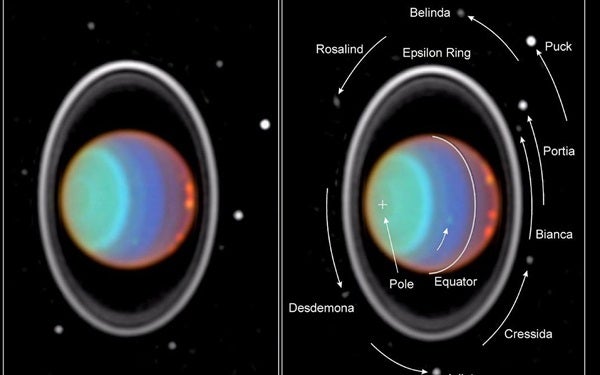Robert Chancia at the University of Idaho and his colleagues set out to better understand Uranus’ Eta ring. They discovered that the ring’s shape is not perfectly circular, but instead it is triangular — and the cause of the distortion is the tiny moon Cressida, just 51 miles (82 kilometers) across. Based on the size and shape of the distortion, the team was able to accurately measure Cressida’s mass and density; they used these qualities to determine that gravitational interactions between Cressida and other nearby moons will mean a collision between Cressida and another moon, most likely Desdemona, is imminent. Their work has been accepted for publication in the Astronomical Journal.
The collision between Cressida and Desdemona, currently orbiting just 560 miles (900km) apart, is likely to take place within the next million years. And they’re not the only two moons destined for doom: In 2012, SETI Institute researchers Robert French and Mark Showalter determined that the moons Cupid and Belinda were likely to collide between 10 and 1,000 million years from now.
These future collisions seem even more probable when viewed in light of two diffuse rings around the planet today that likely formed from the debris of previous collisions between now-long-gone moons.
As a result, Chancia and his colleagues made the first mass measurement of the moon, finding Cressida is about 1/300,000th the mass of Earth’s Moon and has a density 86 percent that of water. This actually makes Cressida denser than many of Saturn’s small moons, indicating that it likely contains a decent amount of rock as well as water ice.
Although several of the planet’s moons are slated to someday collide, the impending collisions might not completely destroy the moons involved. If that happens, Uranus could end up with “new” moons that future astronomers refer to as Cupbel and Cresdemona.
It seems that celebrity names are the only ones subjected to potential mash-ups.
SOURCE: New Scientist











